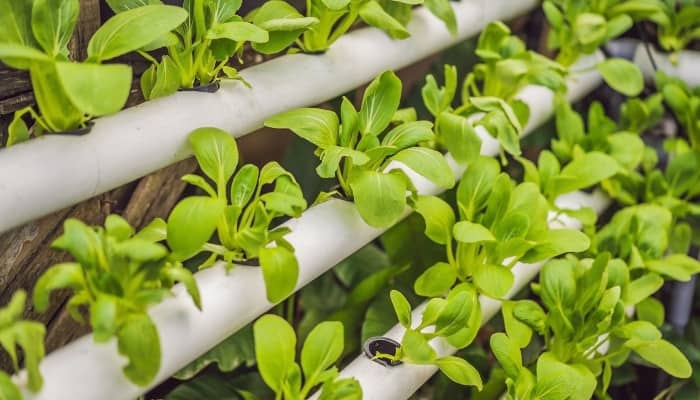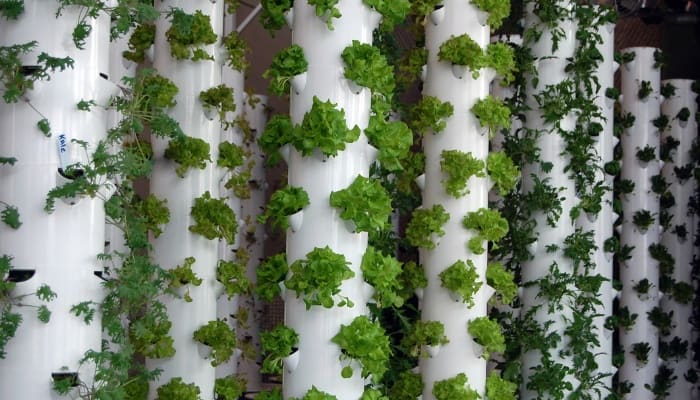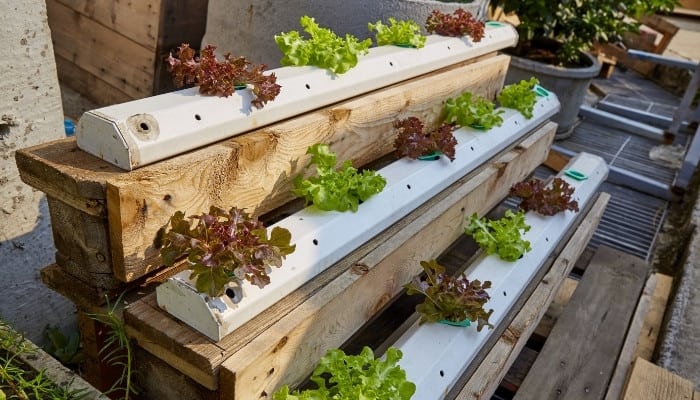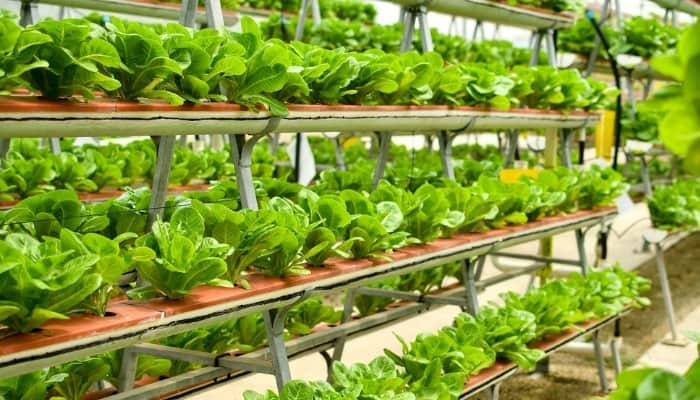If you are searching for information on hydroponic gardens, whether it’s for your first garden or for expanding your current one, you can find helpful tips below on maximizing your growing potential in limited space.
Read on below to fully understand the concept of vertical hydroponics, learn about the different types of systems and best plants to grow, and explore the 5 best vertical hydroponic systems currently available on the market.
What Are Vertical Hydroponic Systems?
In vertical hydroponic systems, plants are cultivated vertically, often in stacked layers or towers, making efficient use of floor space and significantly increasing yield potential compared to traditional soil-based methods.
At the core of a vertical hydroponic system is the efficient delivery of water and nutrients to plants, promoting their growth without the need for soil.
This is achieved through a network of pipes, tubes, and PVC structures, strategically arranged to ensure a high growth rate and optimal nutrient distribution.
Nutrient-rich water is pumped to the top of the system and then allowed to trickle down, providing each plant with the essential elements it needs for healthy development.
One of the key advantages of vertical hydroponics is the ability to customize and optimize the growing environment for different crops.
Leafy greens and herbs, for example, thrive in these systems, where humidity and supplemental lighting can be finely tuned to simulate ideal growing conditions.
This level of control helps growers produce consistent, nutritious leafy greens that often outweigh the yields possible through traditional farming methods.
The implementation of a vertical hydroponic system can range from DIY projects to large-scale, professionally designed setups.
A variety of crops can be grown in these systems, and the vertical orientation allows for better space utilization.
For instance, in an indoor system, a rain tower design may be used, where water flows down inside the structure, ensuring all plants receive an adequate nutrient mix.
Moreover, the automation of certain tasks, such as nutrient delivery through pumps and the option to hang the system as a hanging garden, are possibilities that further enhance the efficiency of vertical hydroponic setups.
Different Types: Stacked Hydroponic Systems & Vertical Towers
Different types of vertical systems offer diverse solutions for efficient plant cultivation. These systems leverage the advantages of both hydroponics and vertical farming, yielding up to 7 times more produce compared to conventional methods.
As the concept of vertical hydroponics continues to evolve, growers have the opportunity to automate tasks, customize conditions, and ensure that every aspect of their system is optimized for growth.
From nutrient film technique setups to hanging garden arrangements, these different types of vertical hydroponic systems demonstrate the adaptable nature of modern farming, promising efficient and high-yield cultivation in any setting.
Stacked Hydroponic System

One prevalent design is the vertical stacked hydroponic system, which features stacked layers of crops, often utilizing PVC pipes.
Nutrient-rich water is pumped from the bottom reservoir, allowing gravity to efficiently distribute water and nutrients to the top and subsequent rows, ensuring even growth throughout the tower.
Net cups are strategically placed within the tower, offering an ideal environment for plants to flourish.
Vertically stacked systems, whether DIY or professionally built, make the most of limited space, creating high-output farms that advance sustainable farming practices.
Tower System

Another innovation is the vertical tower system, also known as rain towers, where water flows down the vertical towers or pipes at a slight angle, providing plants with the necessary nutrients.
This type of vertical hydroponic system may include supplemental lighting and controlled humidity to optimize the growing environment, resulting in higher yields of nutritious leafy greens and herbs.
Benefits of Vertical Hydroponic Systems
Vertical hydroponics presents a host of advantages. Its key benefits include a remarkable 2 to 6 times higher yield compared to traditional soil-based methods due to efficient space utilization.
This space optimization is particularly valuable in urban settings, where confined areas and limited land availability are common.
Control over growth conditions is another advantage, enabling customization of lighting, humidity, and nutrient delivery for consistent, high-output crop production.
Sustainability is addressed through closed-loop water systems, reducing wastage and aligning with eco-friendly farming practices. Moreover, elevated crops in vertical systems can help mitigate pest and disease risks, decreasing the need for chemical interventions.
In simple terms, vertical hydroponics offers a comprehensive solution by boosting yield, optimizing space, promoting sustainability, and minimizing risks.
Vertical Hydroponic Systems: Buying vs. DIY
When it comes to adopting vertical hydroponic systems, individuals face the decision between purchasing pre-made setups or opting for a do-it-yourself approach. Each option has its own merits and considerations.
While purchasing a system provides convenience and support, opting for a DIY project offers creative freedom and cost-effectiveness.
Ultimately, the decision hinges on factors such as technical ability, available time, budget constraints, and the desire for a personalized system that aligns with individual preferences and goals.
Advantages of Purchasing Pre-Made Systems
Buying a pre-designed vertical hydroponic system offers several advantages. Firstly, it saves time and effort as these systems typically arrive ready to assemble and use.
This is particularly beneficial for those without the technical skills or resources to construct a DIY system from scratch.
Additionally, purchased systems often come with warranties, customer support, and detailed instructions, ensuring a smoother experience for beginners.
Advantages of DIY Systems
Conversely, the DIY route offers a unique set of benefits. Building your own vertical hydroponic system provides the opportunity to customize the design to fit specific needs and available space.
This can be an attractive choice for individuals who enjoy hands-on projects and have the skills to create a system tailored to their unique requirements.
DIY systems can also be more budget-friendly, especially for those who already possess some of the necessary materials and tools.
Best Plants for a Vertical Hydroponics System
Vertical hydroponics systems are well-suited for a variety of plants, but certain crops thrive particularly well in these setups.
When selecting plants for your vertical hydroponic system, consider factors such as growth habits, light requirements, and the type of hydroponic system you’re using. Different systems may offer better support for specific plant types.
Additionally, keep in mind that some plants may require additional support structures as they grow to prevent bending or breaking.
Here are some of the best plant options for a vertical hydroponic system:
- Leafy Greens: Plants like lettuce, kale, spinach, and Swiss chard are excellent choices. They have shallow root systems and can thrive in the compact spaces provided by vertical systems. Their rapid growth and continuous harvesting potential make them popular options.
- Herbs: Herbs like basil, mint, cilantro, and parsley are perfect for vertical hydroponics. They not only fit well within the limited space but also provide a burst of flavor to your dishes.
- Strawberries: Vertical systems can provide the support needed for strawberries to grow and dangle, making harvesting easier. These berries thrive in hydroponic setups and are well-suited for the vertical tower design.
- Tomatoes: Certain varieties of tomatoes, known as determinate or bush tomatoes, can be grown successfully in vertical systems. Their compact growth habit makes them suitable for the limited space.
- Peppers: Dwarf or compact pepper varieties can flourish in vertical hydroponic setups. Bell peppers, chili peppers, and other varieties can be grown vertically for efficient space utilization.
- Cucumbers: Vine crops like cucumbers can be trained to grow vertically using trellises or netting in hydroponic systems. This allows them to grow upwards, saving horizontal space.
- Beans: Similar to cucumbers, pole beans can be trained to grow vertically, making them a good fit for these systems.
- Microgreens: These nutrient-dense young greens are well-suited for vertical hydroponics due to their small size and rapid growth. They’re a popular choice for both commercial and home setups.
- Larger Fruiting Plants (with proper support): With appropriate support structures, larger plants like eggplants and small melon varieties can be grown in vertical systems.

1. Aerospring Vertical Hydroponics Indoor Growing System
The first vertical hydroponic system on our list is a super popular aeroponic-style unit that holds 20 gallons of water and grows up to 27 plants at a time.
Thanks to the timed misting/watering and nutrient delivery system, the Aerospring Vertical Hydroponics Indoor Growing System’s design boasts superior ratios of air, oxygen, and nutrients to roots than other units do.
It’s easy to install, doesn’t take long to learn how to use, and includes six built-in grow lights as well.
- Type of system: Aeroponics
- Water capacity: 20 gallons
- Plant capacity: 27
Pros:
- Grows over two dozen plants at once
- Superior air to oxygen technology
- Includes six grow lights
- Works indoors and outdoors
- Easy to install and use
Cons:
- Plants don’t have as much room to grow tall as many classic hydroponic systems
2. Gardyn 1.0 Vertical Indoor Hydroponics Growing System
The second item on our list is another popular one with home hydroponic gardeners and beginners alike – the Garden 1.0 Vertical Indoor Hydroponics Growing System.
The system holds up to 6 gallons of water and allows you to grow up to 30 plants at one time. It also comes with lights, seeds, and everything else you need to actually get started.
Furthermore, the system has a built-in smart assistant that helps you keep the garden unit cared for.
- Type of system: Hydroponic
- Water capacity: 6 gallon
- Plant capacity: 30
Pros:
- Grows up to 30 plants at a time
- No additional seeds, pods, or purchases needed
- AI-based technology for upkeeping your garden
- Built-in grow lights
Cons:
- More expensive than other gardens – but is much smarter too
3. Nutrabinns Hydroponic Tower Grow System
The Nutrabinns Hydroponic Tower Grow System is another impressive vertical hydroponics system and is third on our list.
It’s a popular pick with beginners and experts alike thanks to its 80-pot design that allows for a far large number of plants growing at one time than most systems.
The tank holds 8 gallons of water, and the system’s high-end design saves you money on your power bills.
- Type of system: Aeroponics
- Water capacity: 8 gallons
- Plant capacity: 80
Pros:
- Lab-tested award-winning design
- Grows 80 plants at once
- Crops grow three times faster
- Saves you up to more than 60% on your energy bill
- 40% larger yields
Cons:
- More expensive than some similar units
4. Lettuce Grow 36-Plant Hydroponic Growing System
The Lettuce Grow 36-Plant Hydroponic Growing System is one of the larger systems on our list in terms of water capacity. It holds up to 30 gallons and grows up to 36 plants at one time.
The design is made of food-safe plastic that enables you to use the system indoors or outdoors as you see fit.
It also looks much more aesthetically pleasing than most systems. Some people use them as novelty decorations with living flowers, herbs, and houseplants.
- Type of system: Hydroponic
- Water capacity: 30 gallons
- Plant capacity: 36
Pros:
- Grows larger plants than some systems
- Indoor/outdoor BPA-free design
- Looks great as a novelty/decoration
- Is available in smaller and medium sizes as well
- Includes everything you need to get started
Cons:
- Doesn’t grow as many plants as some other similar systems
5. Aerospring Vertical Hydroponic Outdoor Growing System
The fifth system on our list is the Aerospring Vertical hydroponic Outdoor Growing System, an aeroponic beauty.
The Aerospring Vertical Hydroponic Growing System holds 20 gallons of water in its reservoir. It supports up to 27 plants at a time and has high-grade and silent-running components.
Plus, it’s one of the quicker systems to set up and easiest to use as well.
- Type of system: Aeroponic
- Water capacity: 20 gallon
- Plant capacity: 27
Pros:
- Easy to set up and use
- Works outside
- Silent pump and components
- Made by a trusted/well-known manufacturer
Cons:
- Isn’t designed for indoor use but could possibly work for it
Conclusion
From aeroponic grow towers and NFT systems to classic deep water culture designs featuring trellising, there seem to be more and more hydroponic systems appearing on the market each year.
Which one is right for you? Only you can be the judge, but hopefully, our article helps narrow down your selection!

